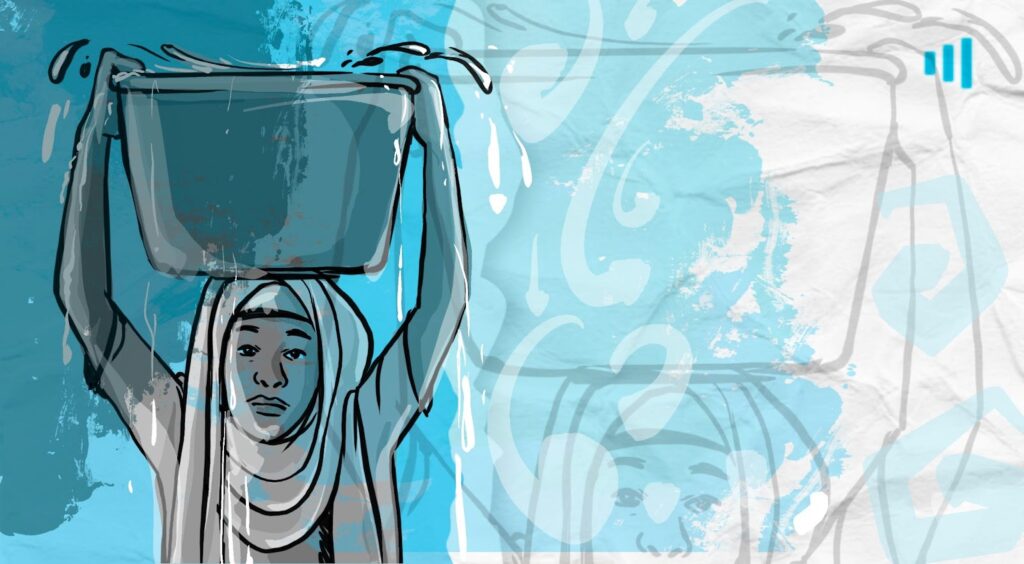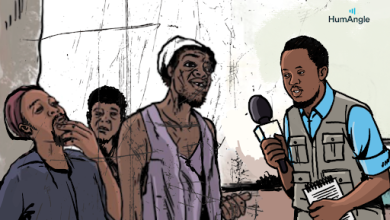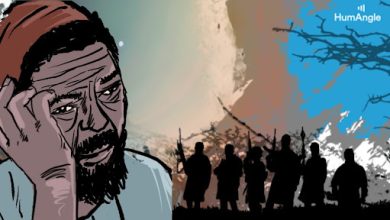How Climate Change Affects Women In Northeastern Nigeria
Climate change contributes to water scarcity, food insecurity, and altered rainfall patterns, detrimentally affecting the well-being and livelihoods of people worldwide. Yet, these impacts are not distributed evenly; they disproportionately affect women.

On a Saturday evening in November last year, a pickup truck came to a stop in front of an Internally Displaced Persons (IDPs) camp in Maiduguri, Nigeria.
Women, including 32-year-old Rifkatu James and 25-year-old Hakuri Yusuf, emerged from the vehicle, announcing their return from their farms. The children, spotting them, rushed out joyfully to greet their mothers, their faces brightening at the sight of them after an absence of about six months. However, the women were not as cheerful despite their longing to reunite with their children. The reason? A poor harvest. Months of hard work and investment had been in vain, as inadequate rainfall had thwarted their efforts.
How would this affect these women?
Impact on livelihood and economic condition
Rifkatu, Hakuri and other women hurried to their farmlands in April 2023 on the outskirts of Maiduguri, in Nigeria’s Northeast. They were full of joy as they planted groundnut, sesame, beans, sorghum, and other seeds, hoping for a bountiful harvest by the end of the year. They envisioned a comfortable life, especially Rifkatu, whose husband was killed by members of the Boko Haram terror group in 2014, and Hakuri, whose husband abandoned her in 2018. Both women were left to provide solely for their children through farming. However, in May, the rain suddenly ceased, and it remained dry until August. Initially, the women hoped for a brief delay, but by June, they sensed it was a drought that could devastate their crops. They were right.
At the beginning of 2023, the Nigerian Meteorological Agency (NiMet) had forecasted a delay in rainfall in certain areas of Borno, accompanied by below-normal precipitation levels ranging from 420-720mm, leading to water stress. The agency recommended several measures for farmers to mitigate the impact, including preserving soil moisture, implementing regular weed control, promoting soil health and crop performance through the increase of soil biodata, and utilising supplementary irrigation during dry spells, among other strategies.
Dr Muhammad Bello Ibrahim, a geography lecturer at the University of Maiduguri explains that there is a decrease in the rainfall patterns in parts of northern and central Borno. He attributes this to absence of open water bodies and vegetation cover in the region.
He explains: “In the whole of Borno, particularly from the central to the northern parts, there are hardly any open water bodies aside from the Lake Chad that would ignite evaporations. Also, in the Sudan and Sahelian zones where Borno is situated, there are few vegetal covers that would supplement the evaporation. If you move around northern and central Borno, you will see that the number of trees is few.”
He added that these few trees undergo significant pressure due to the grazing of livestock such as camels, goats, and sheep. Consequently, there’s insufficient space for adequate evaporation to occur. “As this happens, people that are engaged in agricultural practices would be having it challenging to plant crops for fear of poor cultivation and harvest as a result of poor or lack of rainfall.”
To complement evaporation from Lake Chad and reduce deforestation in the Northeast, several organisations, including the Concern for Climate Change for the Community Initiative (FOURCi), conduct afforestation activities by planting tree seedlings. FOURCi is an organisation trying to mitigate the impacts of climate change by engaging in advocacy and providing training on climate-smart agriculture for farmers, among others.
Bala Gabriel, the organisation’s Executive Director, explains that “Impacts of climate change are more pronounced on women, particularly in the northeast because it intersects with the Boko Haram crisis. Women in the north are at the forefront of some farming activities. They are left with the burden of sorting out food for the family.”
“I invested so much in the farm this season. The land I am farming on was rented. I have been renting it for three years now. I paid ₦150,000 [about $98] as rent this year. I spent another ₦60,000 to purchase the seeds and another ₦85,000 for the land to be cultivated. Unfortunately, the harvest was low,” Rifkatu told HumAngle, sounding sad.

“I harvested 15 bags [approx. 1,500kgs] of groundnut and one bag [approx. 100kgs] of sesame. In previous seasons, I used to harvest 20 bags of groundnut when I planted 15 small bowls, and ten bags of sesame when I planted four small bowls. I used to plant sorghum and beans, too, but not this season because of the rain. The rainfall this season was very low,” she added.
The harvest was disappointingly low for Hakuri as well. Despite planting 20 small bowls of groundnut and ten small bowls of beans, she only managed to harvest a single bag of beans, with no yield for the groundnut.
The women expressed deep frustration over the lack of boreholes or other water sources on the farms for irrigation. “There was no water at all, not even for drinking. We often pay drivers travelling along the Maiduguri Road to bring us water in jerricans,” Hakuri explained.
“Farming is our sole means of livelihood. We rely heavily on the season’s harvest until the next one. Unfortunately, sometimes, our supplies run out before the next harvest arrives. In such instances, we depend on assistance from relatives and friends. And if no help comes, we may go days without food,” she added.
Women like Rifkatu and Hakuri, who were displaced from the Gwoza local government area of Borno state, found refuge at the Divisional Church Council (DCC) camp in Maiduguri. With their men absent, they became the sole heads of their households. Rainfed agriculture is their sole means of sustenance, as they sell parts of the season’s harvest to meet other needs and rely on the rest until the next harvest. However, the impacts of climate change have dashed their hopes for livelihood and economic survival.
According to a report by Frontiers, extreme weather conditions have grave consequences for infectious diseases on maternal, fetal, neonatal, and child health, with maternal malnutrition exacerbating these effects. The likelihood of these is further exacerbated by the drop in crop yields.
Research indicates that globally, around 1.3 billion individuals in low and middle‐income countries (LMICs) reside below the poverty line, with 70 per cent of them being female. Climate change amplifies the unique health requirements of women, particularly during pregnancy, where maternal health and nutrition play a crucial role in the development of the foetus and infant. The economic implications for women are just as prominent.
For Rifkatu, whose son was on admission at the University of Teaching Hospital (UMTH), the situation was even more dire. “My son was sick. So, to cover his medical bills, I hastily sold my harvest. I sold each bag of groundnut at ₦20,000 [about $13]. And I sold the sesame at ₦40,000 [$26],” she told HumAngle. She revealed that she spent about ₦500,000 on medical charges.
Water scarcity depriving women of opportunities
Aisha Babagana, a 25-year-old student at the Ramat Polytechnic Maiduguri, spends over two hours daily with her sisters fetching water for their family’s domestic needs.
“On days when water is available in the community, it takes me no more than 20 minutes to fetch water. However, on days when water is scarce, it can take me up to three hours,” she told HumAngle.
This prolonged water-fetching routine often causes Aisha to miss classes, adversely affecting her education. “If I spend up to three hours fetching water, I usually end up missing classes. It is not every time we can afford to buy water from water vendors. And my brothers are always out at their places of business. So, it is customary for me and my sisters to fetch water for the home’s use,” she explained.
Despite the challenges, this task has created an opportunity for bonding among Aisha and her sisters. “Many girls go to the tap and borehole to fetch water. So, while we wait in line for our turns, we interact and even knit caps. Cap knitting is a source of income for many of us. The proceeds from cap sales enable me to pay for tuition fees in school. Some of us are hairdressers. So, they also plait hair while waiting,” she disclosed.
Aisha and her sisters collect a minimum of 650 litres of water daily to meet the needs of their nine-person family. However, Aisha’s health has been suffering; she has been experiencing fever for about three months, likely due to the physical strain of fetching water and carrying heavy loads on her head from the tap to her home.

A study highlights that Africa, with only nine per cent of global renewable water resources, ranks as the second driest continent globally, following Australia. There has been a noticeable decrease in total precipitation in the northernmost and southernmost regions of the continent. Projections indicate that climate change will worsen this. Due to gender roles, women are affected more.
Another study reveals that in 24 sub-Saharan African countries, between 46 and 90 per cent of women serve as the primary collectors of water, a task consuming over 30 minutes of their time daily. Moreover, across all 24 countries, including Liberia, Cote d’Ivoire, Nigeria, Niger, Ethiopia, Burundi, and Mozambique, 62 per cent of girls, compared to 38 per cent of male children, bear the responsibility of water collection.
In rural communities grappling with water scarcity in the northeast, it is common for women to trek miles, spending up to six hours fetching water. This growing water stress has given rise to what’s termed the “water culture.” In these communities, water is regarded as a precious commodity, with women even presenting it to others during childbirth, in the hopes of reciprocity during their own childbirth.
Dr Ibrahim highlighted the entrenched societal expectation that women are responsible for sourcing water and, in rural areas, gathering fuelwood for household needs. However, with the impacts of climate change becoming increasingly apparent, the distances women must travel to access these resources have significantly increased.
Adaptation strategies
Dr Ibrahim advocates for promoting women’s judicious use of resources to mitigate the effects of climate change. He suggests that women should engage in planting various types of vegetation, not limited to trees but also including shrubs and drought-resistant grasses. This diverse vegetation would increase water vapour levels in the local environment, positively impacting the microclimate of their area. By actively participating in such efforts, women can play a significant role in combating climate change.
Gabriel also proposes a shift away from rainfed agriculture due to the evident presence of drought. He emphasises the importance of building the resilience of women by reintroducing irrigation farming. Furthermore, Gabriel suggests that efforts should focus on educating women about climate-smart agriculture, a concept that teaches individuals how to cultivate small plots of land near their homes to achieve high yields. This approach not only addresses the challenges posed by climate change but also enhances food security and sustainability for communities reliant on agriculture.
Additionally, a study suggests that community-based strategies aimed at enhancing women’s empowerment have been identified as effective mitigation measures to address women’s limited access to education, healthcare, and employment opportunities.
Another study suggests providing government assistance to women residing in regions prone to extreme climatic effects, such as droughts, has been identified as an effective measure to alleviate the health impacts of climate change on women in high‐income countries (HICs). Women were observed to exhibit higher resilience during periods of distress, which was also reported as an adaptive strategy to mitigate the implications of climate change on women’s health.
Support Our Journalism
There are millions of ordinary people affected by conflict in Africa whose stories are missing in the mainstream media. HumAngle is determined to tell those challenging and under-reported stories, hoping that the people impacted by these conflicts will find the safety and security they deserve.
To ensure that we continue to provide public service coverage, we have a small favour to ask you. We want you to be part of our journalistic endeavour by contributing a token to us.
Your donation will further promote a robust, free, and independent media.
Donate HereStay Closer To The Stories That Matter




